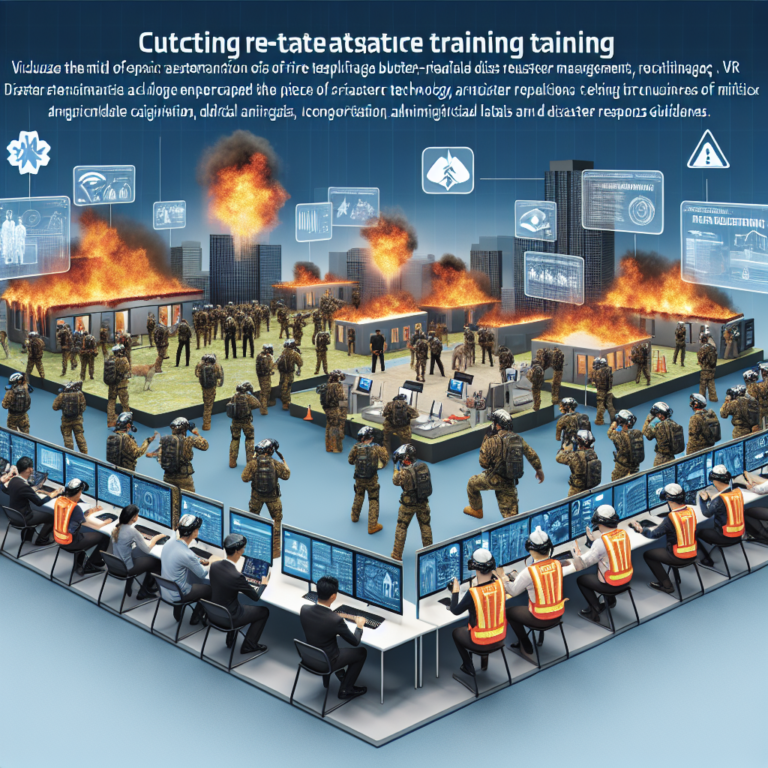Transforming Emergency Response Training with Immersive Technologies 🚀
The Era of Digital Preparedness
In today’s rapidly evolving world, the need for effective emergency response training has never been more critical. With natural disasters, medical emergencies, and unforeseen crises on the rise, organizations and responders are turning to immersive technologies to enhance their preparedness. Immersive technologies, including virtual reality (VR), augmented reality (AR), and simulation training, are revolutionizing how professionals prepare for real-life emergencies.
Understanding Immersive Technologies in Training
Immersive technologies create a realistic learning environment that engages participants effectively. These solutions have been gaining traction in emergency response training due to their ability to replicate high-pressure scenarios without real-world consequences. Here’s how these technologies are being utilized:
1. Virtual Reality (VR): Simulating Real-World Scenarios 🌍
Virtual reality immerses users in a digital environment, allowing them to experience emergency situations hands-on. By using VR headsets, trainees can engage in lifelike simulations that mimic:
- Fire emergencies
- Natural disasters like earthquakes or hurricanes
- Medical emergencies requiring immediate attention
This method not only builds skills but also enhances decision-making under pressure, making responders more effective in real-life situations.
2. Augmented Reality (AR): Enhanced Learning Experiences
Augmented reality overlays digital information onto the real world, providing trainees with additional context and guidance. In emergency response training, AR can:
- Display vital information about a patient’s condition in medical scenarios
- Guide responders through complex procedures with real-time data and visuals
- Assist with navigation and strategic planning during disaster response
This technology ensures that learners are not only trained but also equipped with the tools necessary for effective problem-solving in the field.
3. Simulation and Gamification: Engaging the Learner 🎮
Simulation training allows responders to practice their skills in a risk-free setting. By employing elements of gamification, such as scoring, rewards, and challenges, organizations can improve engagement and retention of knowledge. This approach is particularly beneficial because:
- It fosters teamwork and communication among responders.
- Participants are more likely to remember procedures when they are engaged in a competitive or game-like atmosphere.
- Immediate feedback can be provided, allowing for on-the-spot corrections and improvements.
The Benefits of Immersive Emergency Response Training
The adoption of immersive technologies in emergency response training offers numerous benefits, significantly enhancing preparedness among healthcare providers, first responders, and emergency management officials. Here are some key advantages:
1. Realistic Training Environments
Immersive technologies provide realistic environments that mimic the actual challenges faced during emergencies. This realism helps trainees develop the instincts and skills necessary for quick decision-making.
2. Safety and Risk Reduction
By training in a virtual environment, responders and healthcare professionals can practice high-stakes situations without the risk of injury or unintended consequences. This safety aspect allows for repeat practice until proficiency is achieved without any real-world ramifications.
3. Improved Skill Retention
Studies suggest that experiential learning through VR and AR results in improved retention rates as compared to traditional training methods. The engaging nature of immersive training keeps participants interested, enhancing their ability to recall crucial information during emergencies.
4. Cost-Effective Solutions
While the initial investment in technology may seem high, immersive training can save money in the long run. It reduces the need for physical materials, travel costs, and personnel hours for training events. Additionally, the ability to train multiple individuals simultaneously can significantly cut expenses associated with traditional training methods.
Real-World Applications of Immersive Technologies
The benefits of immersive training are already evident in various emergency response sectors:
1. Healthcare Sector 🏥
Medical professionals are utilizing VR simulations to practice life-saving techniques, diagnostics, and emergency protocols. Scenarios such as handling a mass casualty incident can be practiced repeatedly, enabling teams to respond more effectively during actual events.
2. Fire and Rescue Operations
Firefighters and rescue workers use AR to visualize building layouts, identify hazards, and gain insights into the environmental conditions during an emergency. VR training sessions allow them to experience various fire scenarios, improving their readiness to tackle real fires safely.
3. Disaster Management Agencies
Organizations involved in disaster response employ immersive technologies to prepare personnel for various scenarios such as floods, earthquakes, and terrorist attacks. Training involves elements like crowd control, evacuation procedures, and resource management, all delivered through state-of-the-art simulations.
The Future of Emergency Response Training
As technology continues to advance, the future of emergency response training looks promising. Here are some trends to watch for:
- Artificial Intelligence (AI) Integration: AI will personalize training experiences, adapting scenarios based on individual trainee performance.
- Remote Training: The rise of remote training solutions will make immersive technologies more accessible to responders worldwide, regardless of location.
- Wearable Technology: Wearables will enhance training realism, providing biometric feedback that can be leveraged for personalizing training programs.
With continued advancements in immersive technologies, the landscape of emergency response training is evolving rapidly. By embracing these innovations, organizations can ensure that their teams are well-prepared for any crisis situation that arises. In a world filled with unpredictability, it’s clear that readiness is not just a goal—it’s an absolute necessity.




0 Comments